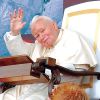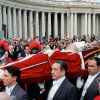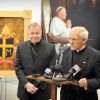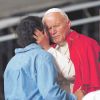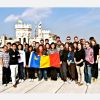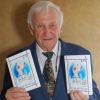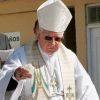What is the new evangelization?
Since the late Pope John Paul II coined the phrase in an address to Latin American bishops in the late 1970s, Catholic thinkers, writers, theologians and pastors have debated what the new evangelization really means. In the lineamenta sent to more than 200 bishops earlier this year in advance of the synod, Archbishop Nikola Eterovic offers several definitions. Among them:
o The new evangelization is primarily addressed to those who have drifted from the Church in traditionally Christian countries.
o There should also be a dialogue with those to whom religion is something foreign.
o The new evangelization is primarily a spiritual activity to recapture the courage and forcefullness of the first Christians and first missionaries.
o As an evangelizer, the Church begins by evangelizing herself.
o Evangelization is facing new challenges which are putting accepted practices in question and are weakening customary, well-established ways of doing things.
o The Church does not give up or retreat into herself; instead, she undertakes a project to revitalize herself.
o The new evangelization is a frame of mind, a courageous manner of acting.
o A new evangelization means, then, to work in our local churches to devise a plan... to transmit the Gospel of hope in a practical way.... becoming more and more the artisan of the civilization of love.
o A new evangelization also means to have the boldness to raise the question of God in the context of these problems.
o In the end, the expression new evangelization requires finding new approaches to evangelization so as to be Church in today’s ever-changing social and cultural situations.
VATICAN CITY - The cameras are trained on the cute baby being foisted up to the pope for a kiss and papal blessing, not on the dapper gentleman trying to handle the precious, often squirming, load with care.
Vatican ushers attend every weekly general audience, helping visitors with special needs and picking out the cutest babies in the crowd for the photo op of a lifetime. And they welcome dignitaries and heads of state visiting the pope with all the pomp and circumstance suited for their stature as "gentlemen in waiting."
These laymen, called "sediari" or chair-bearers, did just that for centuries: carried the pope on an elevated chair high above the crowds so everyone could catch a glimpse of the pontiff.
But Blessed John Paul II discontinued the practice when he was elected in 1978, preferring to walk and be close to the people.
The "sediari" stayed on, but their role no longer included carrying the pope on their shoulders -- until Blessed John Paul's death more than 26 years later.
When he died, Blessed John Paul's body had to be carried by 12 papal gentlemen on a red velvet stretcher in a solemn procession from the Apostolic Palace to St. Peter's Basilica.
Because so many of the papal ushers were young, only a few older veterans knew how to carry a pope either on the portable chair or the stretcher.
All ushers' eyes and ears were on Massimo Sansolini, who served four popes after he became a "sediario" in 1964.
He spelled out the correct procedure for smoothly and decorously lifting and carrying the papal platform so that it would stay as horizontal and secure as possible while the men navigated corridors and numerous marble staircases.
Two of his essential rules: "Carry it with just the shoulder, without help from the hand" and always begin walking with the left foot.
The rules were in his recently published Italian memoir, a follow-up to a volume he published in 1999 in which he told of his life as a papal gentleman, revealing the not-often-seen world of the Apostolic Palace, at the service of the pope.
Sansolini told reporters at the second book's launch April 23 that because there were always 12 "sediari" helping the pope -- the vicar of Christ -- he always felt like one of the apostles -- a servant of the servant of God.
In his book, he described how hard the men tried to remain calm and composed, fighting back the tears, as they transferred the pope's body before the crowds April 4, then carried the cypress casket from St. Peter's Basilica outside to the square during the April 8 funeral.
"No layperson had ever been as close to the sacred person of the pontiff as we had for 26 years straight," he wrote.
While those events briefly put Sansolini and his confreres in the world spotlight, their weekly routine is much less visible.
For the past 16 years, Sansolini has been in charge of helping disabled pilgrims get seating as close to the pope as possible during Wednesday general audiences and other special occasions.
There are special sections in the square or the Paul VI audience hall for church dignitaries, important guests, newlyweds and people with special needs. All the ushers also have their eyes open for parents with tiny infants and help them get as close as they can to the barricade in the general seating section to pass the baby to the pope in the popemobile.
Sansolini said no pope has ever complained about the tradition of individually greeting and blessing the disabled after the general audience, no matter how scarred or infirm they may be: "The pope's love knows no limits."
A typical Wednesday starts very early as Sansolini arranges the seating for the disabled section, leaving room for the wheelchairs between the plastic chairs for the caregivers.
Guests are asked to arrive a couple of hours early before the start of the audience so they can clear security and find their section.
Sansolini said he helps pass the time with all of them, chatting about their lives in whatever language they have in common. Sometimes, he said, just a caress or smile is all that it takes to forge a strong bond.
He said he has been humbled by the heroism of the mothers, fathers and caregivers of the gravely ill and physically or mentally challenged adults and children he sees every week.
"There are women like Mother Teresa all over, on every continent," caring for the unwanted or abandoned.
He said he is always touched by people he meets, from those afflicted with terminal cancer to Iraqi children bearing battle scars, "their tiny bodies, already martyred" in the bloom of their life.
Once he saw a mother come to the audience hall laden with bags and cases, which she scattered on the floor around her.
He was going to gently say something about the disarray, but let it go. He was glad he did, he wrote, because later she pulled out a series of bottles and a syringe and proceeded to feed her child through a stomach tube.
"Every time I am present at an audience I come out with greater faith" from witnessing the unconditional love, joy and hope in people, he said.
"The love of a parent overcomes everything! The human being reaches a fullness of dignity that knows no limits" when it overcomes all challenges and suffering with love and grace, he wrote.
NEW ORLEANS - A major exhibit of the personal effects of Blessed John Paul II, titled "I Have Come to You Again," will open its three-city U.S. tour in the Archdiocese of New Orleans in February 2013, and the exhibit organizer who has handled four previous Vatican exhibits in the United States said he was bracing for record crowds.
Joining Archbishop Gregory M. Aymond of New Orleans April 13 to formally announce the exhibit was Father Malcolm Neyland, a priest of the Diocese of Lubbock, Texas, who also serves as director of the nonprofit National Exhibits Association.
VATICAN CITY - Almost 30 years after the still-unexplained disappearance of a teenage girl who lived with her family at the Vatican, the Holy See continues to be willing to cooperate with efforts to solve the mystery, the Vatican spokesman said.
Jesuit Father Federico Lombardi issued a three-page statement April 14 recalling how often Pope John Paul II appealed for the release of Emanuela Orlandi after her presumed kidnapping in 1983 and how top Vatican officials formally answered investigators' questions then and in subsequent investigations carried out in the late 1980s and mid-1990s.
VATICAN CITY - On the seventh anniversary of the death of Blessed John Paul II, Pope Benedict XVI paid homage to one of his predecessor's innovations: World Youth Day.
Greeting an estimated 5,000 cheering young people from Spain April 2, Pope Benedict said they were "the protagonists and principal recipients of this pastoral initiative promoted vigorously by my beloved predecessor, Blessed John Paul II, whose passage to heaven we remember today."
Seeing Scripture come to life in the Holy Land
There are many graces a young Catholic pilgrim might expect to receive from visiting the Holy Land.
In his Jubilee letter, Pope John Paul II stressed that walking in our “travelling companion” Jesus’ footsteps could transform our own spiritual journeys immeasurably. So a pilgrim might hope that Scripture would come alive in the streets or that faith might be affirmed by experiencing the enormous history of the sights.
John Paul II DVD raises funds for Ottawa basilica
William Zlepnig was flabbergasted when he saw a stamp exhibit dedicated to Blessed John Paul II on display in Ottawa last April. He liked it so much he decided to sponsor the creation of a DVD that would keep the exhibit alive forever while at the same time helping to raise money for the restoration at St. Patrick’s Basilica.
“The basilica did a whole restoration outside and it’s (cost) up in the millions of dollars,” Zlepnig, a member of the St. Patrick’s Basilica Knights of Columbus, told The Catholic Register.
Titled A Stamp Tribute to John Paul II, about $4 or $5 of every DVD sold will go towards the restoration fund, he said.
New Missal bodes well for the new evangelization
Less than two weeks after we began using the new translation of the Roman Missal, parishes and priests are getting used to the new prayers. Before the novelty wears off though, we ought to note that the very fact that the new translation exists at all is a promising sign for the Church’s witness in the 21st century.
Consider simply this: Whether at a parish in Bombay or Belfast, whether the Mass is being offered in Brisbane or Brandon, Catholics are praying the same prayers. For a universal Church whose liturgy is in Latin, that should not be surprising. Yet over the past decades centrifugal forces have been strong in the Church, with a certain liturgical mentality taking hold that emphasized the differences in various localities rather than the unity. When differing educational jurisdictions within a single country have a difficult time harmonizing their curriculum and examinations, it is no small achievement to have a single English translation used both in South Africa and South Dakota.


